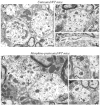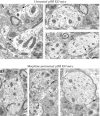Regulation of delta-opioid receptor trafficking via mu-opioid receptor stimulation: evidence from mu-opioid receptor knock-out mice
- PMID: 12832511
- PMCID: PMC6741164
- DOI: 10.1523/JNEUROSCI.23-12-04888.2003
Regulation of delta-opioid receptor trafficking via mu-opioid receptor stimulation: evidence from mu-opioid receptor knock-out mice
Abstract
We recently demonstrated that prolonged treatment with morphine increases the antinociceptive potency of the delta-opioid receptor (deltaOR) agonist deltorphin and promotes cell surface targeting of deltaORs in neurons of the dorsal horn of the rat spinal cord (Cahill et al., 2001b). In the present study we examined whether these effects were mediated selectively via muOR. Using the same intermittent treatment regimen as for morphine, we found that methadone and etorphine, but not fentanyl, enhanced [D-Ala2]-deltorphin-mediated antinociception. However, continuous delivery of fentanyl for 48 hr resulted in augmented deltaOR-mediated antinociception when compared with saline-infused animals. Time course studies confirmed that a 48 hr treatment with morphine was necessary for the establishment of enhanced deltaOR-mediated antinociception. The observed increases in deltaOR agonist potency and deltaOR plasma membrane density were reversed fully 48 hr after discontinuation of morphine injections. Wild-type C57BL/6 mice pretreated with morphine for 48 hr similarly displayed enhanced deltaOR-mediated antinociception in a tonic pain paradigm. Accordingly, the percentage of plasma membrane-associated deltaOR in the dorsal horn of the spinal cord, as assessed by immunogold electron microscopy, increased from 6.6% in naive to 12.4% in morphine-treated mice. In contrast, morphine treatment of muOR gene knock-out (KO) mice did not produce any change in deltaOR plasma membrane density. These results demonstrate that selective activation of muOR is critical for morphine-induced targeting of deltaOR to neuronal membranes, but not for basal targeting of this receptor to the cell surface.
Figures










Similar articles
-
Prolonged morphine treatment targets delta opioid receptors to neuronal plasma membranes and enhances delta-mediated antinociception.J Neurosci. 2001 Oct 1;21(19):7598-607. doi: 10.1523/JNEUROSCI.21-19-07598.2001. J Neurosci. 2001. PMID: 11567050 Free PMC article.
-
Mu-opioid receptor knockout prevents changes in delta-opioid receptor trafficking induced by chronic inflammatory pain.Pain. 2004 Jun;109(3):266-273. doi: 10.1016/j.pain.2004.01.011. Pain. 2004. PMID: 15157687
-
Morphine-induced changes in delta opioid receptor trafficking are linked to somatosensory processing in the rat spinal cord.J Neurosci. 2004 Jun 16;24(24):5549-59. doi: 10.1523/JNEUROSCI.2719-03.2004. J Neurosci. 2004. PMID: 15201327 Free PMC article.
-
Receptor expression and signaling properties in the brain, and structural ligand motifs that contribute to delta opioid receptor agonist-induced seizures.Neuropharmacology. 2023 Jul 1;232:109526. doi: 10.1016/j.neuropharm.2023.109526. Epub 2023 Mar 31. Neuropharmacology. 2023. PMID: 37004753 Free PMC article. Review.
-
Recent advances on the δ opioid receptor: from trafficking to function.Br J Pharmacol. 2015 Jan;172(2):403-19. doi: 10.1111/bph.12706. Epub 2014 Jul 1. Br J Pharmacol. 2015. PMID: 24665909 Free PMC article. Review.
Cited by
-
Distribution of delta and mu opioid receptor mRNA in rodent dorsal root ganglia neurons.Eur J Neurosci. 2022 Aug;56(3):4031-4044. doi: 10.1111/ejn.15733. Epub 2022 Jun 14. Eur J Neurosci. 2022. PMID: 35674691 Free PMC article.
-
Antinociceptive effects of two deltorphins analogs in the tail-immersion test in rats.Peptides. 2013 Jan;39:103-10. doi: 10.1016/j.peptides.2012.11.008. Epub 2012 Nov 23. Peptides. 2013. PMID: 23183627 Free PMC article.
-
Peripheral δ-opioid receptors attenuate the exercise pressor reflex.Am J Physiol Heart Circ Physiol. 2013 Oct 15;305(8):H1246-55. doi: 10.1152/ajpheart.00116.2013. Epub 2013 Aug 9. Am J Physiol Heart Circ Physiol. 2013. PMID: 23934854 Free PMC article.
-
Molecular Perspectives for mu/delta Opioid Receptor Heteromers as Distinct, Functional Receptors.Cells. 2014 Mar 5;3(1):152-79. doi: 10.3390/cells3010152. Cells. 2014. PMID: 24709907 Free PMC article.
-
Clinical opioids differentially induce co-internalization of μ- and δ-opioid receptors.Mol Pain. 2018 Jan-Dec;14:1744806918769492. doi: 10.1177/1744806918769492. Epub 2018 Mar 27. Mol Pain. 2018. PMID: 29587571 Free PMC article.
References
-
- Abdelhamid EE, Takemori AE ( 1991) Characteristics of μ and δ opioid binding sites in striatal slices of morphine-tolerant and -dependent mice. Eur J Pharmacol 198: 157–163. - PubMed
-
- Abdelhamid EE, Sultana M, Portoghese PS, Takemori AE ( 1991) Selective blockage of δ-opioid receptors prevents the development of morphine tolerance and dependence in mice. J Pharmacol Exp Ther 258: 299–303. - PubMed
-
- Ango F, Robbe D, Tu JC, Xiao B, Worley PF, Pin JP, Bockaert J, Fagni L ( 2002) Homer-dependent cell surface expression of metabotropic glutamate receptor type 5 in neurons. Mol Cell Neurosci 20: 323–329. - PubMed
Publication types
MeSH terms
Substances
LinkOut - more resources
Full Text Sources
Molecular Biology Databases
Research Materials
